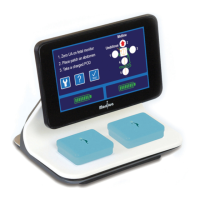
Do you have a question about the GE Novii and is the answer not in the manual?
| Wireless Communication | Bluetooth |
|---|---|
| Mobility | Portable |
| Technology | Fetal Monitoring |
| Parameters Monitored | Fetal Heart Rate, Maternal Heart Rate |
| Connectivity | Bluetooth |
Overview of the Monica Novii Pod Fetal-Maternal Monitor and its purpose in monitoring pregnant mothers.
Specifies the patient population and conditions for which the Novii system is indicated for intrapartum monitoring.
Lists situations and equipment where the Novii system should not be used for patient safety and compatibility.
Outlines what users can expect regarding FHR signal quality and potential for patient ambulation.
Details the capabilities and specifications of the Novii Pod, including battery life and wireless range.
Describes the functionalities and connection points of the Novii Interface device for data display.
Lists the characteristics and usage guidelines for the disposable Novii Patch, including shelf life and wear time.
Explains how ECG signals are detected and processed to derive Fetal Heart Rate (FHR) and Maternal Heart Rate (MHR).
Details how EMG signals from the myometrium are processed to represent Uterine Activity (UA).
Instructions for preparing the patient's skin and checking the patch expiration date.
Step-by-step guide for correctly positioning the Novii Patch on the maternal abdomen.
Specific guidance for patch placement in cases of displaced umbilicus or significant pannus.
Detailed procedure for skin exfoliation and electrode placement for optimal signal acquisition.
Information on potential skin reactions, correct removal technique, and assessing patient allergies.
Guidance on preventing skin redness caused by excessive or improper skin preparation techniques.
Procedure to verify the correct connection and function of the Novii Interface with the fetal monitor.
Steps to connect the Novii Pod to the Patch and Interface, and initiate monitoring.
Steps to resolve signal quality problems related to skin preparation affecting electrode contact.
Explains how to read and interpret the graphical trace data, including identifiers and signal thickening.
Description of the primary display screen of the Novii Interface and its key elements.
How to monitor FHR signal quality and Pod battery levels on the Novii Interface.
Instructions for safely removing and replacing the Novii Pod during a monitoring session.
Guidance on safely removing the Novii Patch to minimize skin irritation and prevent damage.
Steps to resolve issues with the Novii Interface's connectivity or functionality.
Identifies common causes for degraded FHR signal quality, including noise and placement issues.
How patient position affects FHR signal acquisition and troubleshooting techniques.
Addresses problems related to electrode detachment, poor skin contact, or adhesion.
Guidance on recognizing and interpreting FHR artifact on the monitor trace.
Using an ultrasound transducer for FHR confirmation during signal loss or artifact.
Explains causes of false contractions on the UA trace, such as patient movement, and how to mitigate them.
Details how to select UA sensitivity settings for optimal interpretation of uterine activity.
Identifies reasons for low or absent UA signals and provides troubleshooting steps.
Explains signal delays from Novii and their impact on monitoring, especially during decelerations or contractions.
Provides warnings and guidance regarding combining Novii with other monitoring methods due to timing discrepancies.
Procedures for cleaning and disinfecting the Novii Pod and Interface according to hospital protocol.